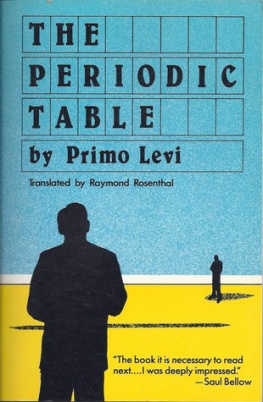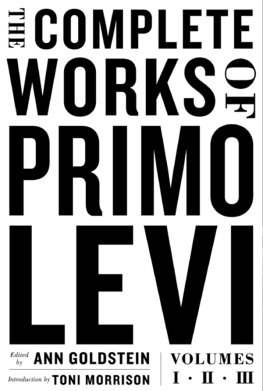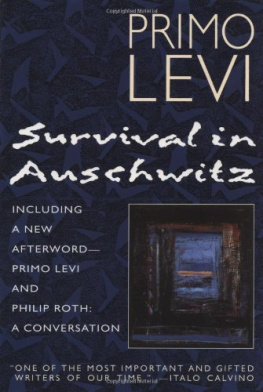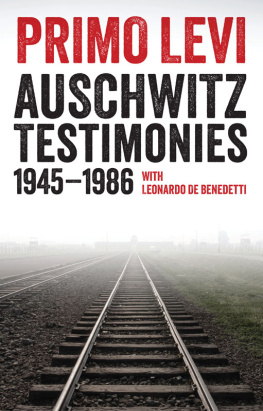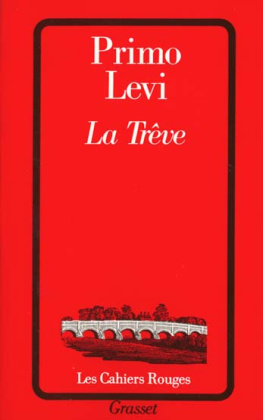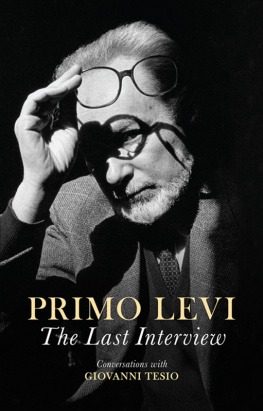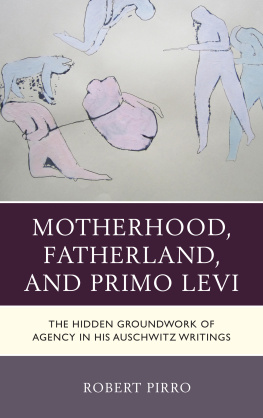T h e
P e r i o d i c
T a b l e
P r i m o L e v i
Translated from the Italian by
Raymond Rosenthal
NEW YORK
SCHOCKEN BOOKS
English translation copyright 1984 by Schocken Books Inc.
All rights reserved under International and Pan-American Copyright Conventions. Published in the United States by Schocke n Books Inc., New York. Distributed by Pantheon Books, a division of Random House, Inc., New York. Originally published in Italy as Il Sistema Periodico by Giulio Einaudi editore, s. p. a., Turin, Italian text copyright 1975 by Giulio Einaudi editore, s. p. a. Originally published in hardcover by Schocken Books in 1984.
Library of Congress Cataloging-in-Publication Data Levi, Primo
The periodic table
Translation of: Il sistema periodico. I. Title.
PQ4872. E8S51 3 198 4 854. 914 84-545 3
ISBN 0-8052-1041-5
Manufactured in the United States of America [95] 19 18 17 16
C O N T E N T S
Argon
Hydrogen
Zinc
Iron
Potassium
Nickel
Lead
Mercury
Phosphorus
Gold
Cerium
Chromium
Sulfur
Titanium
Arsenic
Nitrogen
Tin
Uranium
Silver
Vanadium
Carbon
Ibergekumene tsores iz gut tsu dertsejlin.
Troubles overcome are good to tell.
Yiddish Proverb
T h e
P e r i o d i c
T a b l e
ARGON
There are the so-called inert gases in the air we breathe. They bear curious Greek names of erudite derivation which mean the New, the Hidden, the Inactive, and the Alien. They are indeed so inert, so satisfied with their condition, that they do not interfere in any chemical reaction, do not combine with any other element, and for precisely this reason have gone undetected for centuries. As late as 1962 a diligent chemist after long and ingenious efforts succeeded in forcing the Alien (xenon) to combine fleetingly with extremely avid and lively fluorine, and the feat seemed so extraordinary that he was given a Nobel prize. They are also called the noble gasesand here theres room for discussion as to whether all noble gases are really inert and all inert gases are noble. And, finally, they are also called rare gases, even though one of them, argon (the Inactive), is present in the air in the considerable proportion of 1 percent, that is, twenty or thirty times more abundant than carbon dioxide, without which there would not be a trace of life on this planet.
The little that I know about my ancestors presents many similarities to these gases. Not all of them were materially inert, for that was not granted them. On the contrary, they wereor had to bequite active, in order to earn a living and because of a reigning morality that held that he who does not work shall not eat. But there is no doubt that they were inert in their inner spirits, inclined to disinterested speculation, witty discourses, elegant, sophisticated, and gratuitous discussion. It can hardly be by chance that all the deeds attributed to them, though quite various, have in common a touch of the static, an attitude of dignified abstention, of voluntary (or accepted) relegation to the margins of the great river of life. Noble, inert, and rare: their history is quite poor when compared to that of other illustrious Jewish communities in Italy and Europe. It appears that they arrived in Piedmont about 1500, from Spain by way of Provence, as seems proven by certain typical toponymic surnames, such as Bedarida-Bdarrides, Momigliano-Montmlian, Segre (this is a tributary of the Ebro which flows past Lrida in northeastern Spain), Fo-Foix, Cavaglion-Cavaillon, Migliau-Millau; the name of the town Lunel near the mouth of the Rhone between Montpellier and Nmes was translated into the Hebrew yareakh (moon; luna in Italian), and from this derived the Jewish-Piedmontese surname Jarach.
Rejected or given a less than warm welcome in Turin, they settled in various agricultural localities in southern Piedmont, introducing there the technology of making silk, though without ever getting beyond, even in their most flourishing periods, the status of an extremely tiny minority. They were never much loved or much hated; stories of unusual persecutions have not been handed down. Nevertheless, a wall of suspicion, of undefined hostility and mockery, must have kept them substantially separated from the rest of the population, even several decades after the emancipation of 1848 and the consequent flow into the cities, if what my father told me of his childhood in Bene Vagienna is true. His contemporaries, he said, on coming out of school used to mock him without malice, greeting him with the corner of their jackets gathered in their fists to resemble a donkeys ear and chanting, Pigs ear, donkeys ear, give em to the Jew thats here. The allusion to the ear is arbitrary, and the gesture was originally the sacrilegious parody of the greeting that pious Jews would exchange in synagogue when called up to read the Torah, showing each other the hem of the prayer shawl whose tassels, minutely prescribed by ritual as to number, length, and form, are replete with mystical and religious significance. But by now those kids were unaware of the origin of their gesture. I remember here, in passing, that the vilification of the prayer shawl is as old as anti-Semitismfrom those shawls, taken from deportees, the SS would make underwear which then was distributed to the Jews imprisoned in the Lager.
As is always the case, the rejection was mutual. The minority erected a symmetrical barrier against all of Christianity (gojim, narelim, Gentiles, the uncircumcised), reproducing on a provincial scale and against a pacifically bucolic background the epic and Biblical situation of the chosen people. This fundamental dislocation fed the good-natured wit of our uncles (barbe in the dialect of Piedmont) and our aunts (magne, also in the dialect): wise, tobacco-smelling patriarchs and domestic household queens, who would still proudly describe themselves as the people of Israel.
As for this term uncle, it is appropriate here to warn the reader immediately that it must be understood in a very broad sense. It is the custom among us to call any old relation uncle, even if he is a distant relation, and since all or almost all of the old persons in the community are in the long run relations, the result is that the number of uncles is very large. And then in the case of the uncles and aunts who reach an extremely old age (a frequent event: we are a long-lived people, since the time of Noah), the attribute barba (uncle), or, respectively, magna (aunt) tends gradually to merge with the name, and, with the concurrence of ingenious diminutives and an unsuspected phonetic analogy between Hebrew and the Piedmontese dialect, become fixed in complex, strange-sounding appellations, which are handed down unchanged from generation to generation along with the events, memories, and sayings of those who had borne them for many long years. Thus came into existence Barbait (Uncle Elijah), Barbasachn (Uncle Isaac), Magnaita (Aunt Maria), Barbamisn (Uncle Moses, about whom it is said that he had the quack pull his two lower incisors so as to hold the stem of his pipe more comfortably), Barbasmeln (Uncle Samuel), Magnavigaia (Aunt Abigail, who as a bride had entered Saluzzo mounted on a white mule, coming up the ice-covered Po River from Carmagnola), Magnafria (Aunt Zepora, from the Hebrew Tsippora which means bird: a splendid name). Uncle Jacob must have belonged to an even remoter period. He had been to England to purchase cloth and so wore a checked suit; his brother Barbapartin (Uncle Bonaparte, a name still common among the Jews, in memory of the first ephemeral emancipation bestowed by Napoleon), had fallen from his rank as uncle because the Lord, blessed be He, had given him so unbearable a wife that he had had himself baptized, became a monk, and left to work as a missionary in China, so as to be as far away from her as possible.
Next page
